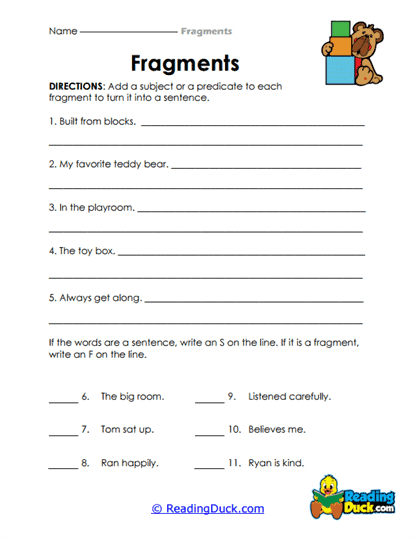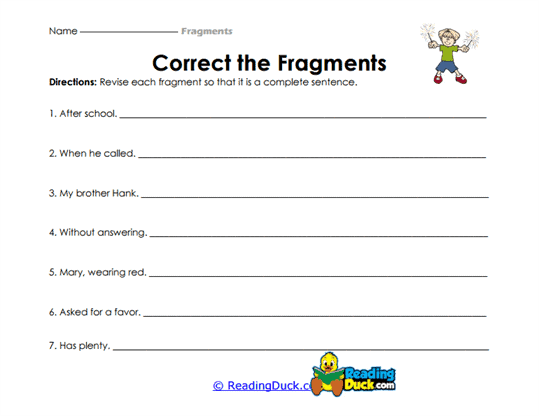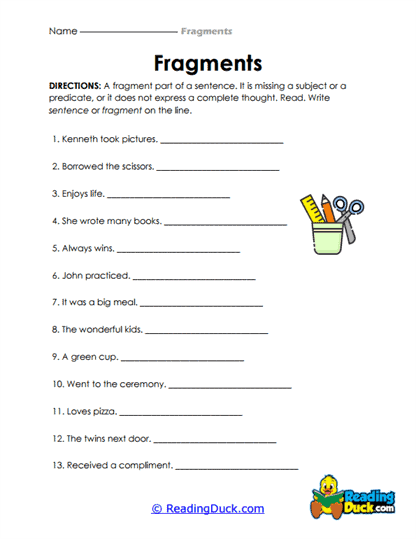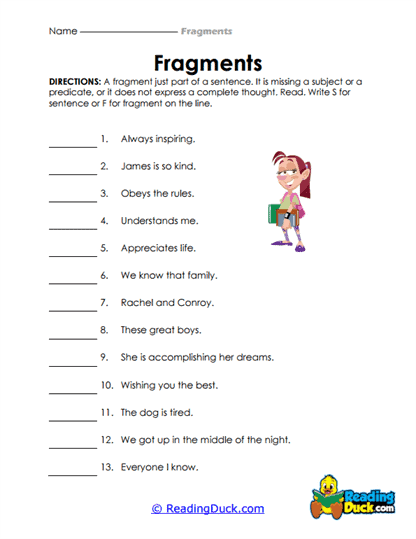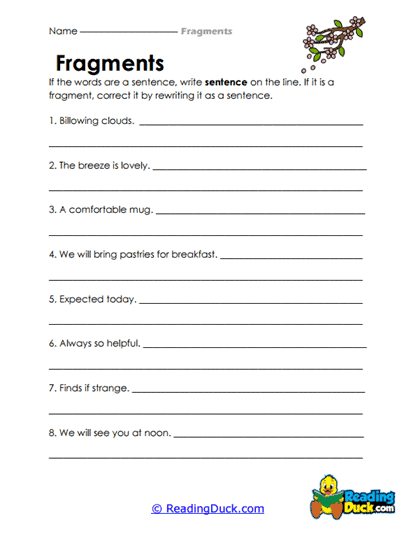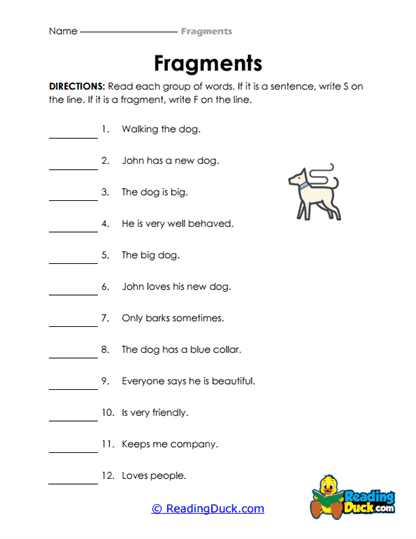Fragments Worksheets
About Our Fragments Worksheets
Our Fragments worksheets are designed to help students identify and correct sentence fragments, one of the most common mistakes in writing. These worksheets provide targeted exercises that guide learners through the process of recognizing incomplete thoughts and turning them into full, grammatically correct sentences. By offering structured practice, this collection helps students gain confidence in their ability to write complete sentences that convey clear, coherent ideas.
Whether used in the classroom or at home, these worksheets are a valuable resource for educators and parents who want to help students strengthen their writing skills. The carefully crafted exercises progressively build students' understanding of sentence structure, helping them move from recognizing fragments to effectively correcting them. This collection is ideal for students at various grade levels who need practice with sentence completeness and clarity.
Understanding Sentence Fragments
A sentence fragment is a group of words that looks like a sentence but doesn’t express a complete thought. Fragments are missing essential components, such as a subject, verb, or complete idea, making the sentence incomplete. Teaching students to identify fragments is a crucial part of helping them write more effectively and clearly.
Key Points About Sentence Fragments:
- Lack of a Subject or Verb: Fragments often miss one of the core components of a sentence. For example, "Running through the park" is a fragment because it doesn’t have a subject performing the action.
- Incomplete Thought: Even if a sentence has both a subject and a verb, it may still be a fragment if it doesn’t express a complete idea. For instance, "Although she finished her homework" is a fragment because it leaves the reader wondering what happened next.
- Dependent Clauses: Sometimes, fragments occur when writers use a dependent clause as a complete sentence. A dependent clause cannot stand alone because it relies on additional information to make sense. For example, "Because the weather was bad" is a fragment without further explanation.
How to Identify and Correct Fragments:
- Look for Missing Parts: Check if the sentence has both a subject and a verb, and make sure it expresses a complete thought.
- Combine with Other Sentences: Some fragments can be corrected by connecting them to a nearby sentence, turning them into a full idea. For example, "Running through the park. She smiled." can become "She smiled while running through the park."
- Rewrite the Fragment: If a fragment stands alone, it may need to be rewritten entirely to form a complete sentence. For example, "Because he was tired" becomes "He went to bed early because he was tired."
By understanding how fragments disrupt the flow of writing, students can learn to avoid them and create stronger, more coherent sentences. Our Fragments worksheets provide ample practice in identifying, correcting, and preventing sentence fragments, helping students to write with greater clarity and effectiveness.
Developing Mastery Through Targeted Practice
The Fragments worksheets are structured to guide students from the basics of identifying sentence fragments to correcting them in a variety of contexts. By providing clear explanations and a range of practice exercises, these worksheets support students at every stage of learning, helping them build mastery over time.
The worksheets start by introducing the concept of fragments, with simple examples that help students recognize incomplete sentences. As students progress, they are encouraged to not only identify fragments but also correct them by adding missing elements, combining them with other sentences, or rewriting them altogether. This gradual increase in complexity ensures that students gain a deeper understanding of sentence structure and can apply their knowledge to their writing.
Key Skills Reinforced:
- Identifying Fragments: Recognizing sentences that are incomplete or lack essential components.
- Correcting Fragments: Adding subjects, verbs, or additional details to complete the thought.
- Combining Sentences: Learning how to join fragments with nearby sentences to create a cohesive and complete sentence.
- Preventing Future Fragments: Developing an understanding of how to avoid fragment mistakes in their own writing.
Through consistent practice, students internalize these skills, which helps them improve their writing fluency and avoid common pitfalls like sentence fragments. The structured progression of these worksheets ensures that students are always building on their previous knowledge, allowing them to advance confidently in their writing abilities.
User-Friendly PDF Format and Answer Keys for Easy Assessment
Our Fragments worksheets are available in a convenient PDF format, making them easy to download, view, and print. This flexibility allows teachers to integrate them seamlessly into classroom lessons or assign them as homework, while parents can use them for extra practice at home. Each worksheet is designed with clear instructions and examples, making it accessible for independent use by students as well.
In addition, each worksheet includes a downloadable answer key, which provides the correct versions of sentences that were originally fragments. This feature helps teachers and parents assess student progress quickly and accurately. By reviewing the answer key, they can identify patterns in student errors and offer targeted feedback that helps learners improve their writing skills.
Tips for Evaluating Student Work:
- Focus on Accuracy: Ensure students are correctly identifying fragments and making the necessary changes to create complete sentences.
- Encourage Revision: Ask students to rewrite fragments in multiple ways to explore different methods of correcting incomplete sentences.
- Provide Specific Feedback: When a student misses a fragment, explain why it’s incomplete and how they can fix it. This personalized guidance helps deepen their understanding.
The combination of PDF worksheets and answer keys provides a streamlined approach to practice and assessment, ensuring that educators and parents have the resources they need to support student learning effectively.
Meeting Educational Standards and Supporting Differentiated Learning
Our Fragments worksheets are aligned with commonly used educational standards, ensuring that they meet the objectives of national and state curriculums. These worksheets support essential language arts skills, helping students develop a strong understanding of sentence structure, grammar, and writing conventions. Teachers can integrate these worksheets into their lesson plans, confident that they are helping students meet key benchmarks in writing proficiency.
Moreover, these worksheets are designed to accommodate students at different skill levels. By offering a range of exercises—from simple identification tasks to more complex sentence corrections—the worksheets can be adapted to meet the needs of both struggling and advanced learners.
Differentiation Strategies:
- Adjust the Complexity: For students who need more support, begin with worksheets that focus on recognizing fragments in simple sentences. For more advanced students, provide exercises that involve correcting more complex sentence fragments.
- Tailor Pacing: Allow students to work at their own pace, ensuring they fully understand the concept of fragments before moving on to more challenging tasks.
- Encourage Peer Review: Have students work together to identify and correct fragments, promoting collaboration and reinforcing their understanding of sentence structure.
By offering differentiated tasks, these worksheets cater to a wide range of learning styles and abilities, ensuring that every student can benefit from the practice provided.
Versatile Use in Writing Lessons and Beyond
The Fragments worksheets are highly adaptable and can be used in a variety of instructional settings. Teachers can incorporate them as warm-up activities at the start of a writing lesson to review basic sentence structure, or they can assign them as review exercises after teaching sentence fragments. These worksheets can also be used to reinforce learning during larger writing projects, ensuring that students avoid fragments while drafting essays or reports.
Practical Suggestions for Using the Worksheets:
- Daily Warm-Ups: Use a worksheet at the beginning of each writing class to refresh students' understanding of sentence completeness.
- Homework Assignments: Assign worksheets as independent practice to reinforce the day’s lesson.
- Test Preparation: Use the worksheets to prepare students for grammar and writing assessments by reviewing sentence fragments.
- Group Activities: Pair students to work together on identifying and correcting fragments, encouraging collaborative learning.
By integrating these worksheets into regular writing lessons, teachers provide students with ongoing practice in sentence construction, helping them develop stronger, more cohesive writing skills. Additionally, the versatility of the worksheets makes them a valuable tool for students who need extra support in mastering sentence structure and avoiding fragments.
Our Fragments worksheets provide students with the tools they need to improve their sentence-writing skills and avoid common mistakes. By offering a range of exercises that progressively build their knowledge, these worksheets help learners at all levels develop a solid understanding of how to identify and correct sentence fragments. Whether used in the classroom or at home, this collection supports students in becoming more confident, effective writers who can create clear, complete, and grammatically sound sentences.

